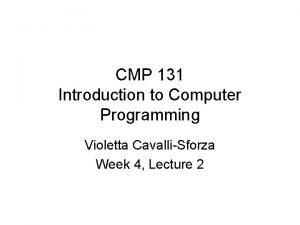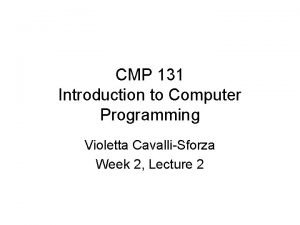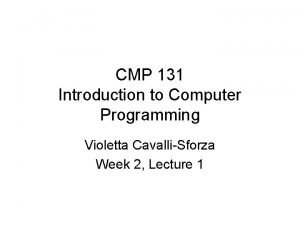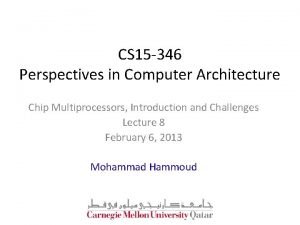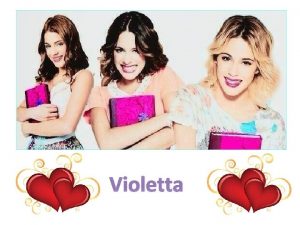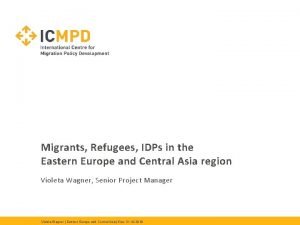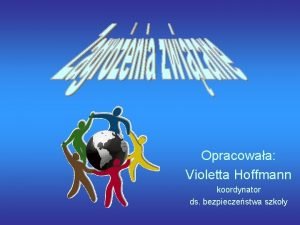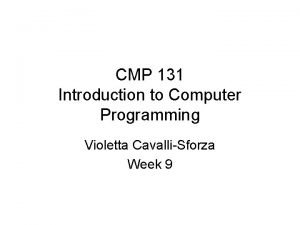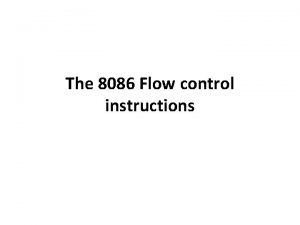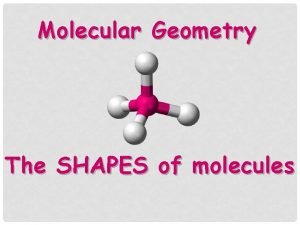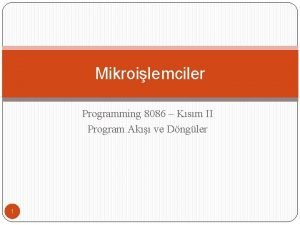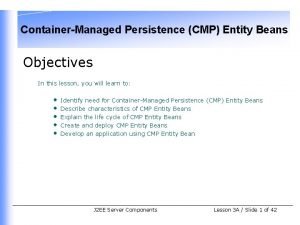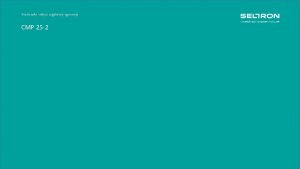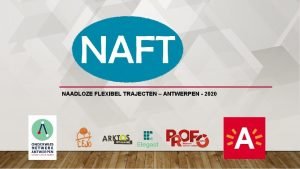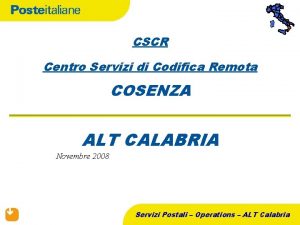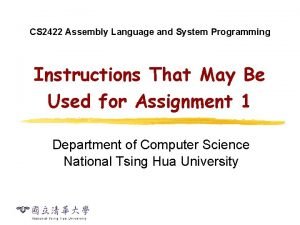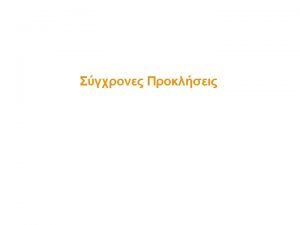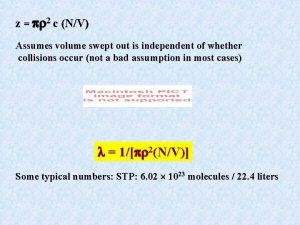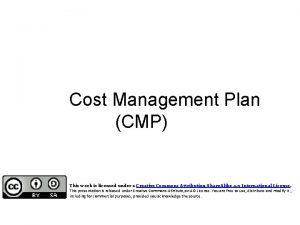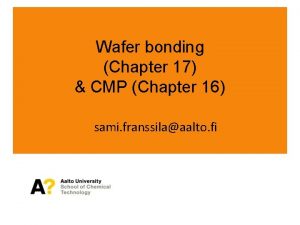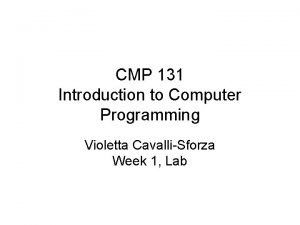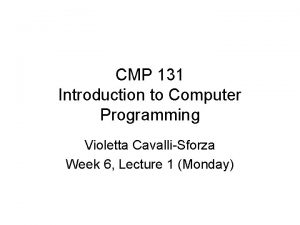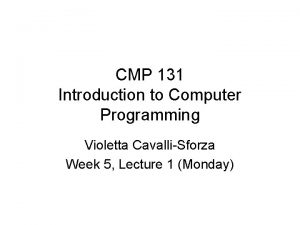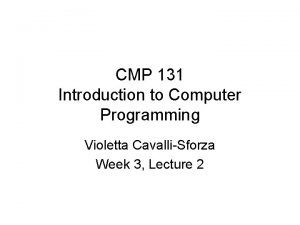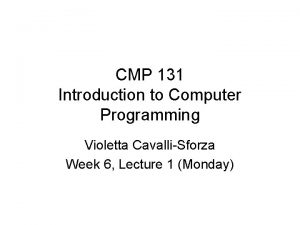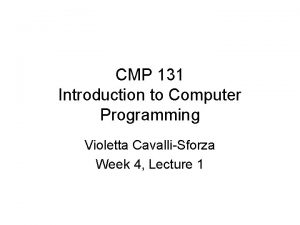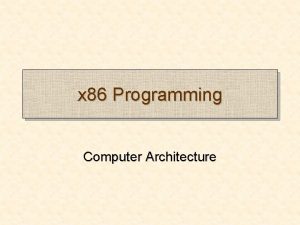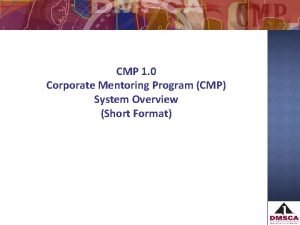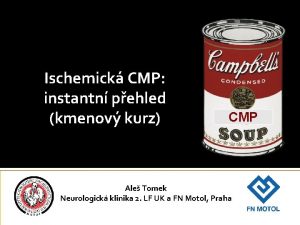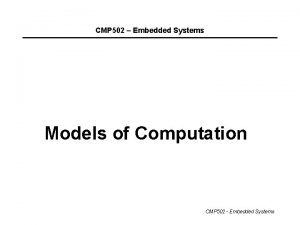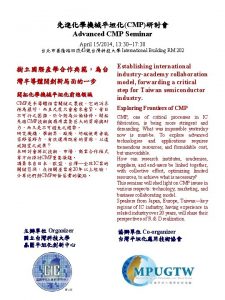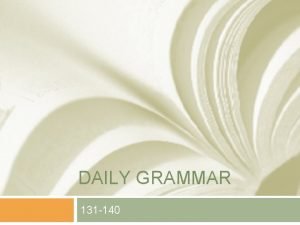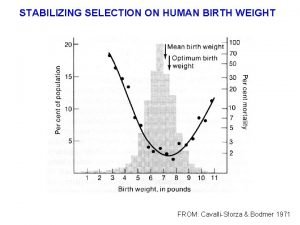CMP 131 Introduction to Computer Programming Violetta CavalliSforza




























- Slides: 28

CMP 131 Introduction to Computer Programming Violetta Cavalli-Sforza Week 1, Lecture 2 28 -February-2007 CMP 131 Introduction to Computers and Programming 1

Outline of Topics • Review briefly last class • More details about hardware • Software/Hardware interface – Data and program representation – Machine arithmetic 28 -February-2007 CMP 131 Introduction to Computers and Programming 2

Last Class • • Course Description Logistics Assessments (Grading) Homework – First assignment will come out Monday 28 -February-2007 CMP 131 Introduction to Computers and Programming 3

Last Class (2) • Computers: What’s in them? – Hardware – Software • • Hardware devices Computers through time Hardware trends Hardware/software trends 28 -February-2007 CMP 131 Introduction to Computers and Programming 4

Why Take This Course? • Be more familiar with PCs • Have a basic understanding of programming and the programming process • Develop critical thinking & problem solving capabilities • Learn other programming languages faster & easier 28 -February-2007 CMP 131 Introduction to Computers and Programming 5

Why Pascal? • One of the first structured programming languages • It influenced the design of its successors – Modula 2, Oberon (by N. Wirth) – Modula 2+, Modula 3 (DEC, Olivetti) – Java – Not C or C++ 28 -February-2007 CMP 131 Introduction to Computers and Programming 6

Today’s Lecture • Review of computers and hardware – Some more information • More about software • Programming languages – Low and high-level languages – Viewing programming through different languages • Introduction to the Pascal IDE environment 28 -February-2007 CMP 131 Introduction to Computers and Programming 7

Computer Systems • Computers – Devices for performing computations at high speeds with great accuracy – A machine that can be programmed to manipulate symbols. Can perform complex & repetitive procedures quickly, precisely and reliably. Can quickly store and retrieve large amounts of data. • Program – A set of instructions for a computer to follow, written in specific programming language 28 -February-2007 CMP 131 Introduction to Computers and Programming 8

Computer Systems • Hardware (HW) – Actual physical machines (equipment) that make up the computer • Software (SW) – A collection of programs used by a computer – A set of instructions provided by the programmer that the computer follows. – Program instructions have to be stored in main memory before they can be executed. 28 -February-2007 CMP 131 Introduction to Computers and Programming 9

Computer Systems • Computer Categories: – Microcomputers (Personal computers / PCs) • Used by a single person – Workstations: • Largest microcomputers – Minicomputers: • Can be used by many people simultaneously by using several terminals connected to the same CPU – Main frame computers: • Faster & larger than minicomputers – Super computers: • Most powerful mainframe computers • Of which category is you computer at home? ? 28 -February-2007 CMP 131 Introduction to Computers and Programming 10

Hardware (HW): Organization • Computer HW usually consists of: – – CPU Main memory (RAM & ROM) I/O Devices Secondary Memory • CPU & main memory are the heart of the computer • Usually the CPU, main memory and secondary memory are housed in a single cabinet I/O Devices CPU Secondary Memory Main Memory 28 -February-2007 CMP 131 Introduction to Computers and Programming 11

Hardware (HW): Central Processing Unit (CPU) • Executes programs • Performs calculations – Arithmetic • Add, subtract, divide, multiply, … etc. – Logical • Compare, test for true/false • Controls & coordinates the other parts of the computer. 28 -February-2007 CMP 131 Introduction to Computers and Programming 12

Hardware (HW): Memory • Main (Primary) Memory: – Ordered sequence and specific number of memory locations (Bytes, words) that have unique addresses indicating their relative positions – Fast, expensive, short term memory – Holds intermediate results and serves as “scratch paper” – Needed to carry out program instructions – Types: • RAM: Random Access Memory (vs. Sequential Access Memory) • Volatile (i. e. contents disappear when the computer is switched off) • Writable (except where forbidden by the software) • ROM: Read Only Memory • Non-volatile • Also usually random access 28 -February-2007 CMP 131 Introduction to Computers and Programming 13

Hardware (HW): Memory • Secondary (auxiliary) memory – Used for keeping a permanent records of information – Holds programs and data between jobs – Keeps data or program files for later use – Slower, cheaper, long-term memory – Common forms • Diskettes, magnetic tapes, hard disk, CD-ROM’s, DVD – Some types are removable 28 -February-2007 CMP 131 Introduction to Computers and Programming 14

Hardware (HW) • I/O (Input/Output) devices – Allow the user to communicate with the computer. – A single computer could be connected to more than one input or output device. – Examples: • Input: Keyboard, mouse, scanner, voice • Output: Screen, printer, voice 28 -February-2007 CMP 131 Introduction to Computers and Programming 15

Hardware/Software Architectures • Mainframe Era – 1940’s-70’s: mainframe computer, minicomputers – Environments: • Batch environments, batch processing – Files are basis for I/O: fixed formats, minimal device I/O – Error recovery – Lack of timing constraints • Interactive environments – Terminal and file I/O: – Interactive error handling – Faster performance 28 -February-2007 CMP 131 Introduction to Computers and Programming 16

• Personal Computers Era – 1978: the Apple II ran BASIC • Educational use – 1981: IBM released the first PC – 1984: Macintosh – Window environments: • OO models are ideal (Smalltalk) • Must interact with many I/O devices (file I/O is less important) – Embedded systems • Error handling • Real-time response • Distributed systems with concurrently running tasks 28 -February-2007 CMP 131 Introduction to Computers and Programming 17

• Networking Era: – LANs (Local Area Networks): client-server model • Airline reservations, banking – Internet • 70’s: ARPANET: telnet, FTP, SMTP protocols • late 80’s: HTML and HTTP added – Issues and Effects: • Static web pages with URLs for access URL = Uniform Resource Locator • Dynamic web pages for e-commerce (Perl, JAVA, etc. ) • Security • Performance (multiple clients) – Offloading work to client 28 -February-2007 CMP 131 Introduction to Computers and Programming 18

Hardware/Software Concepts • Computers manipulate instructions and data – Represented in similar ways – Used in different ways – Representation is binary (digital hardware is binary) • Numbers vs. symbols – Computers represent everything as numbers – But numbers can represent symbols – Can perform “symbolic” computation • Beginning of Artificial Intelligence 28 -February-2007 CMP 131 Introduction to Computers and Programming 19

HW/SW Concepts: Data · What is it? - Numbers, characters, images, or other method of recording - Can be assessed by a human or (especially) input into a computer, stored and processed there, or transmitted on some digital channel. - Nearly always represent data in binary. - Has no meaning on its own. - When interpreted by data processing system it takes on meaning and becomes information. · Storage – Setting of individual bits to specific values, destroying its previous contents · Retrieval – Copying the contents of a particular memory cell to another storage area. – Original data remains unchanged 28 -February-2007 CMP 131 Introduction to Computers and Programming 20

HW/SW Concepts: Representation • Digit / Bit – Smallest unit of information/storage, sufficient to hold one bit – Can take one of two values (true/false, 1/0, or yes/no) – Corresponds to an input/output being on or off • Byte – Smallest addressable unit of storage – Usually 8 bits – Typically holds one character – Can represent 256 different values 28 -February-2007 CMP 131 Introduction to Computers and Programming 21

HW/SW Concepts: Representation • Word – Fundamental unit of storage in a computer – Word size is one of its chief distinguishing characteristics of a computer – Typical size in modern computers: 32 bits (4 bytes) or 64 bits (8 bytes) – An instruction is usually one or more words long – A word can be used to hold a whole number of characters 28 -February-2007 CMP 131 Introduction to Computers and Programming 22

Decimal Number System • A base 10 system • Each digit position can hold 10 values (0 -9) Ex. 1234 = 4*1 + 3 * 10 + 2*100 + 1*1000 = 4*100 + 3 * 101 + 2*102 + 1*103 28 -February-2007 CMP 131 Introduction to Computers and Programming 23

Binary Number System • A base 2 system • Each digit position can hold 2 values (0 -1) Ex. 1011 • Decimal conversion – Equals: 1*20 + 1*21 + 0*22 + 1*23 – Equals: 1 + 2 + 0 + 8 = 11 • Maximum number of values in 4 bits: 16 – 0 to 15 • Maximum number of values in 8 bits: 256 – 0 to 255 [or -128 to 127] – This is how much you can store in a byte 28 -February-2007 CMP 131 Introduction to Computers and Programming 24

Binary Numbers 28 -February-2007 0000 0 0001 1 0010 2 0011 3 0100 4 0101 5 0110 6 0111 7 1000 8 1001 9 1010 10 1011 11 1100 12 1101 13 1110 14 1111 15 CMP 131 Introduction to Computers and Programming 25

Binary Addition 1010 + 0101 = ----1111 10 + 5= -----15 1010 + 0111 = ----0001 10 + 7= -----17 => 1 28 -February-2007 1010 + 0011 = 3 = -----1101 13 OVERFLOW!!! CMP 131 Introduction to Computers and Programming 26

Other Number Systems • Hexadecimal: base 16 – Each digit can hold 16 values (0 -9, A-F) – Ex: A 02 F – Decimal conversion? – Note: 1 hex digit = 4 binary digits • Octal: base 8 – Each digit can hold 8 values (0 to 7) – Ex: 127 – Decimal conversion? 28 -February-2007 CMP 131 Introduction to Computers and Programming 27

Logical Operations • AND: – 1 AND 1 = 1 – Everything else = 0 • OR – 0 AND 0 = 0 – Everything else = 1 • XOR (Exclusive OR) – 0 AND 1 = 1 – 0 AND 0 = 0, 1 AND 1 = 0 28 -February-2007 CMP 131 Introduction to Computers and Programming 28
 Violetta cavalli-sforza
Violetta cavalli-sforza Violetta cavalli sforza
Violetta cavalli sforza Cmp programming
Cmp programming Cmp in computer architecture
Cmp in computer architecture Parejas de violetta
Parejas de violetta Violetta wagner
Violetta wagner Violetta cavalli sforza
Violetta cavalli sforza Violetta cavalli sforza
Violetta cavalli sforza Violetta hoffmann
Violetta hoffmann Violetta cavalli-sforza
Violetta cavalli-sforza Python programming an introduction to computer science
Python programming an introduction to computer science Perbedaan linear programming dan integer programming
Perbedaan linear programming dan integer programming Greedy vs dynamic programming
Greedy vs dynamic programming Definition of system programming
Definition of system programming Linear vs integer programming
Linear vs integer programming Definisi integer
Definisi integer What is cmp in microprocessor
What is cmp in microprocessor Onh nonbonding electrons
Onh nonbonding electrons Assembly cmp komutu
Assembly cmp komutu Cmp entity bean
Cmp entity bean Metoda ścieżki krytycznej cpm
Metoda ścieżki krytycznej cpm Cmp 25
Cmp 25 Slidetodoc.com
Slidetodoc.com Videocodifica poste italiane
Videocodifica poste italiane Cmp instruction example
Cmp instruction example Ibm cmp
Ibm cmp Cavge
Cavge Cmp plan
Cmp plan Bonding
Bonding
